
Caladenia, commonly known as spider orchids, is a genus of 350 species of plants in the orchid family, Orchidaceae. Spider orchids are terrestrial herbs with a single hairy leaf and a hairy stem. The labellum is fringed or toothed in most species and there are small projections called calli on the labellum. The flowers have adaptations to attract particular species of insects for pollination. The genus is divided into three groups on the basis of flower shape, broadly, spider orchids, zebra orchids and cowslip orchids, although other common names are often used. Although they occur in other countries, most are Australian and 136 species occur in Western Australia, making it the most species-rich orchid genus in that state.
Caladenia robinsonii, commonly known as the Frankston spider orchid is a plant in the orchid family Orchidaceae and is endemic to Victoria. It is a ground orchid with a single hairy leaf and one or two red and creamy-yellow flowers with dark red glandular tips on the sepals. In 2010 only about forty specimens of this plant, growing in a single population were known.

Caladenia abbreviata, commonly known as the coastal spider orchid, is a plant in the orchid family Orchidaceae and is endemic to the south-west of Western Australia. It has a single erect, hairy leaf and up to three pale, creamy-yellow flowers on a flowering stem up to 35 cm (10 in) high. Although the flowers have long, thread-like petals and sepals, they are shorter and darker than those of other spider orchids. It is a rare, relatively recently discovered species although often found near human activities.
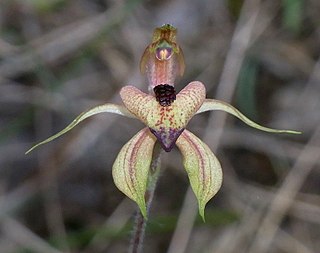
Caladenia cardiochila, commonly known as thick-lipped spider-orchid, fleshy-lipped caladenia and heartlip spider-orchid, is a plant in the orchid family Orchidaceae and is endemic to Victoria and South Australia. It is a ground orchid with a single hairy leaf and one or two yellowish-green, red-striped flowers on a thin, wiry stem.
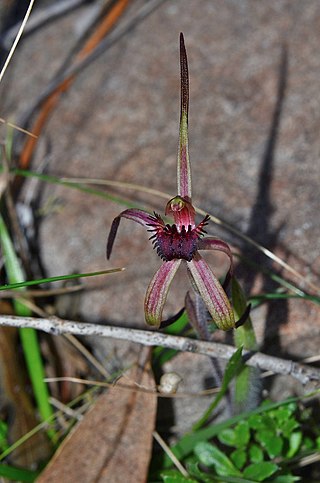
Caladenia caudata, commonly known as tailed spider orchid, is a plant in the orchid family Orchidaceae and is endemic to Tasmania. It is a ground orchid with a single hairy leaf and up to four red, or yellow and red flowers with dark red to almost black tips.

Caladenia clavigera, commonly known as plain-lip spider orchid or clubbed spider orchid is a plant in the orchid family Orchidaceae and is endemic to Australia. It is a ground orchid which grows as scattered individuals or in small colonies in Victoria, New South Wales and South Australia. It has a single leaf and one or two small yellowish-green and red flowers.
Caladenia concinna, commonly known as the neat spider orchid, is a plant in the orchid family Orchidaceae and is endemic to Australia. It is a ground orchid with a single hairy leaf, and usually a single greenish flower with red stripes on the petals and sepals.
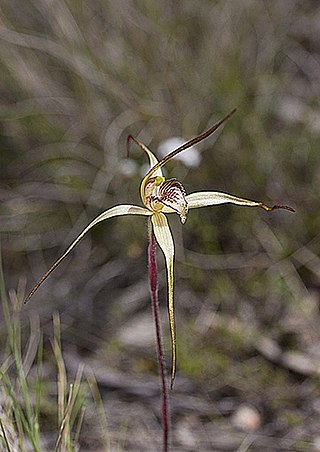
Caladenia echidnachila, commonly known as the fawn spider orchid, is a plant in the orchid family Orchidaceae and is endemic to Tasmania. It is a ground orchid with a single, hairy leaf and one or two fawn-coloured flowers with thin red lines on the sepals and petals.
Caladenia helvina, commonly known as the summer spider orchid, is a plant in the orchid family Orchidaceae and is endemic to Tasmania. It is a ground orchid with a single hairy leaf and usually a single greenish-yellow to pale yellow flower with reddish teeth on the sides of the labellum and reddish calli along its mid-line.
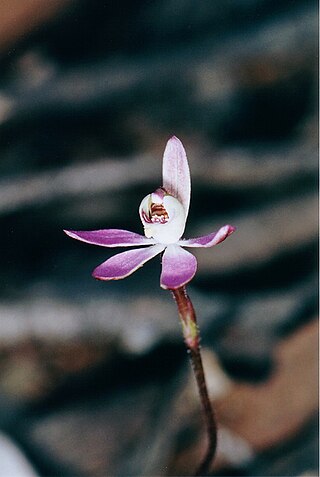
Caladenia mentiens, commonly known as lesser fingers, is a species of orchid endemic to south-eastern Australia which grows singly, or in small, loose groups. It has a single, sparsely hairy, erect, linear leaf and a single whitish or pinkish coloured flower with a darker back and a cream-coloured labellum.
Caladenia patersonii is a plant in the orchid family Orchidaceae and is native to Victoria and Tasmania. It is a ground orchid with a single hairy leaf and one or two creamy-white, yellowish or pink flowers.

Caladenia reticulata, commonly known as the veined spider orchid, is a plant in the orchid family Orchidaceae and is endemic to Victoria and South Australia. It is a ground orchid with a single, hairy leaf and usually only one yellowish-green and red flower.
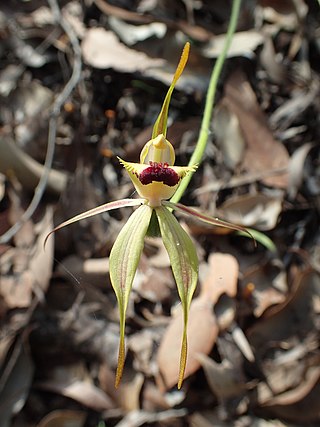
Caladenia rhomboidiformis, commonly known as the diamond spider orchid, is a species of orchid endemic to the south-west of Western Australia. It has a single erect, hairy leaf and one or two green, yellow and red flowers. Until 1971 It was known as a variety of the green comb spider orchid Caladenia dilatata then, until 1989 as a variety of the clubbed spider orchid, Caladenia longiclavata.
Caladenia richardsiorum, commonly known as the little dip spider orchid, Richards' spider orchid or robe spider orchid, is a plant in the orchid family Orchidaceae and is endemic to South Australia. It is a ground orchid with a single erect, hairy leaf and usually only one yellowish-green flower. It is similar to the endangered Mellblom's spider orchid but has a much larger leaf and the petals lack glandular tips.
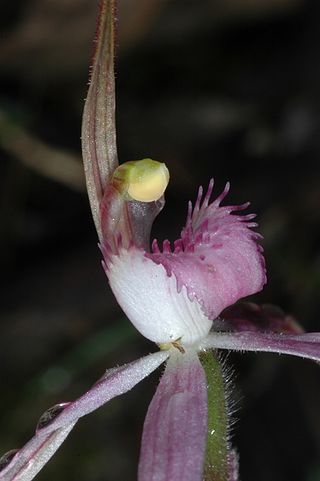
Caladenia rosella, commonly known as the rosella spider orchid is a plant in the orchid family Orchidaceae and is endemic to south-eastern Australia. It is a ground orchid with a single hairy leaf and a single scented pink flower. Although it may have had a wider distribution in the past, the total number of plants in 2000 was estimated to be 120 in four populations in Victoria. There is a single record from New South Wales but the orchid is classified as "extinct" in that state.

Caladenia tessellata, commonly known as the thick-lip spider-orchid, is a plant in the orchid family Orchidaceae and is endemic to south-eastern Australia. It is a ground orchid with a single hairy leaf and one or two yellowish-green flowers with dark red markings.

Caladenia stricta, commonly known as the upright spider orchid or rigid-combed spider-orchid is a plant in the orchid family Orchidaceae and is endemic to southern continental Australia. It is a ground orchid with a single leaf and usually only one pale green flower with red lines along the sepals and petals.

Caladenia tensa, commonly known as the rigid spider orchid is a plant in the orchid family Orchidaceae and is endemic to southern continental Australia. It is a ground orchid with a single leaf and one or two pale green flowers with red stripes. It is mainly only found in the Little Desert National Park in Victoria and in the far south-east of South Australia but there are four records from New South Wales.
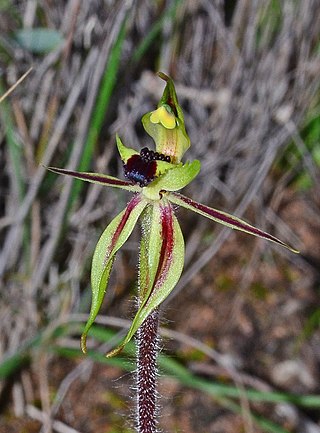
Caladenia toxochila, commonly known as the bow-lip spider orchid is a plant in the orchid family Orchidaceae and is endemic to south-eastern Australia. It is a ground orchid with a single, sparsely hairy leaf and one or two yellowish-green flowers with red stripes. It occurs in Victoria and South Australia and resembles the related Caladenia concinna from New South Wales.

Caladenia villosissima, commonly known as the hairy spider orchid, is a plant in the orchid family Orchidaceae and is endemic to Victoria. It is a ground orchid with a single densely hairy leaf and a single pale green flower with red stripes along the sepals and petals. It is a poorly known species and there is insufficient information about its distribution and abundance to determine whether or not it is endangered.















